In first part the optimal control of singular system with a quadratic cost functional using walsh function is considered. After introducing walsh function in the beginning we develop an operational matrix for solving singular state equations. To demonstrate the validity and applicability of the technique, a numerical example is included
Keywords |
| Optimal control, singular system, orthogonal function, operational matrix, walsh function. |
INTRODUCTION |
| Operational matrices were constructed using orthogonal functions for solving identification and optimisation problems
of dynamic systems, was initially established in 1975 when the Walsh-type operational matrix was constructed by the
present authors(Chen et al.,1965).Since then, many operational matrices based on various orthogonal functions, like
Laguerre (Hwang et al.,1981 & King et al.,1979),Legendre(Chang et al.,1984),Fourier(Paraskevopoulos et al.,1985),
and, Chebyshev (Paraskevopoulos et al.,1985), block pulse(Chen et al.,1977) had developed. Orthogonal functions
deals with various problems of dynamic systems as it reduces the problems to those of solving algebraic equations. The
operational matrix of integration eliminate the integral operation as in this approach differential equations are converted
into integral equations through integration(Leila Ashayeri et al.,2012). |
| Singular system model is necessary for description of such a system which leads to the violation of casuality
assumption. Singular systems also arise naturally in describing large scale systems; examples occur in power and
interconnected systems(Iman ZamanI et al., 2011). |
| Optimal control of singular system via orthogonal functions has been presented, among others, by Balachandran and
Murugesan(K. Balachandran et al.,1992), Shafiee and Razzaghi(M. Shafiee et al.,1998) and Razzaghi and Marzban (M.
Razzaghi et al., 2002). |
| Very few work exist in the field of singular system therefore many challenging and unsolved problems have to face. |
PRELIMINARY DEFINITION |
A. Walsh function and its properties |
| A periodic function may be expanded into Fourier series. Analogously speaking, afunction, f(t), which is absolutely
integrable in (0,1] may be expanded into series of Walsh. |
 |
| where |
 |
| are determined such that the following error is minimized: |
 |
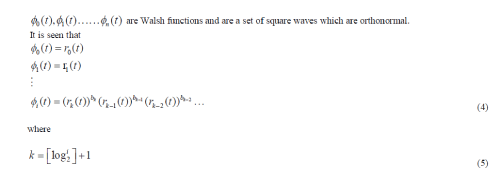 |
| where means taking the integer part of • and 1 1 , , , k k b b b is the binary number expression of i and ( ) k r t is
the Rademacher function. |
| To draw the wave form of any Walsh function becomes a trivial matter if we use the above mentioned decomposition
technique. |
| Let us then return to the Walsh coefficient evaluation for a function. Consider a given function f ( t ) = t. It is desired to
expand it into Walsh series. Substituting the function f(t)= t into (2), we have |
 |
B. Integration and operational matrix |
| In this section we will derive a method by which we can perform any integration by multiplying a constant matrix.
Let us take Φ0 ,Φ1 Φ4.... and integrate them; we will have various triangular waves (Z.H.Jiang et al).If we evaluate the
Walsh coefficients for these triangular waves, the following formula for approximation will be obtained: |
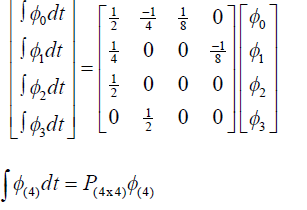 |
| The subscript means the dimension taken. It is preferable to take 2Ω , where Ω is an integer, as a dimension number.
Making this choice will enable us to obtain simple results and easier calculation(Chih-Fan Chen et al.,1975).
It is noted that |
 |
SINGULAR SYSTEM |
| Consider a singular system described by |
 |
 |
| Certain features of this case that are of special interest may be list, and will serve as points of contrast with the case
of nonsingular case(G. C. Verghese et al.,1981). |
| 1. The number of degrees of freedom of system is reduced to |
| f = rankE |
| 2. The transfer function G(s) may no longer be strictly proper. |
| 3. The free response of the system in this case exhibits exponential motions. In addition, however it may contain
impulsive motions. |
| Definition: Singular system is regular if and only if there exists a scalarλ such that (λ E − A)−1 exists. |
OPTIMAL CONTROL OF SINGULAR SYSTEM |
| In this section, we consider the LQR problem for linear time-invariant singular systems. Suppose that the optimization
problem can be stated as follows:
minimize |
 |
and  |
| For simplicity, we assume that Q and R are symmetric positive definite matrices. The Hamiltonian function is given by |
 |
| Necessary conditions imply that |
 |
| that is, |
 |
 |
| where λ* satisfies the following equation: |
 |
| and the boundary condition are specified as |
 |
 |
 |
| where S is a constant matrix to be determined. Put this in (13) we get |
 |
| Substituting (20) in (11),we get |
 |
| By (14), (15), (19), (21), we have |
 |
| that is |
 |
| Since this is true for any x* , we obtain the following Ricatti equation for singular system: |
 |
| By (20) , the optimal state derivative feedback control is given by (Yuan-Wei Tseng et al.,2013): |
 |
| And the closed loop system becomes |
 |
WALSH SERIES SOLUTION TO THE PROBLEM |
| Firstly we normalize the problem because Walsh series is defined in the 0 to 1 interval |
 |
| Then (16) becomes |
 |
| Next, assume x*(p) and p* (p) to be expanded into Walsh series and we can determine its coefficients |
 |
| where C is an 2nXm matrix, and Φ (p) ,an m-vector. |
| To perform integration on (29) eqn (6) is applied: |
 |
| Substituting (30) and (29) into (28) gives |
| Defining k as |
 |
 |
| Solving (32) forC ,we obtain the Walsh coefficients of the rate variable x*(p) rate co-state variable p* (p) .Then
substitute them into (30) .The answer of x(p) and p(p) in terms of Walsh function are finally obtained. |
RESULTS |
| Let us consider the example |
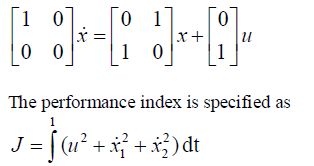 |
| The the state variable x(t) and optimal control law u(t) are computed with m=4. Fig. 1, 2, 3. shows the result. |
| Fig.1 shows the trajectory of 1x (t) for m=4.The result can be improved by using higher values of m. |
| Fig.2 shows the state trajectory of x2 (t) for m=4.If resolution increases then time difference also increases. |
| Fig.3 shows the trajectory of optimal control u(t) for m=4 and tε [0,1).This is new approach for obtaining the optimal
control of singular systems with quadratic cost function. |
CONCLUSION |
| In this paper, a technique has been developed for obtaining the optimal control of singular systems with quadratic cost
functional using walsh functions. The proposed approach is computationally simple. Since walsh functions are
piecewise constant, one has to choose a large value for m in order to improve the accuracy. |
Figures at a glance |
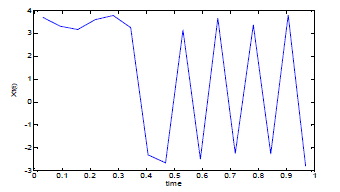 |
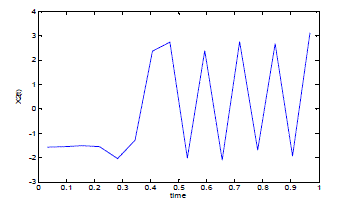 |
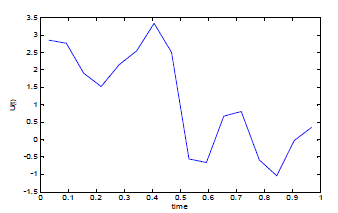 |
| Figure 1 |
Figure 2 |
Figure 3 |
|
References |
- Chang, R.Y., and Wang, M.L., “Legendre polynomials approximation to dynamical linear state space equations with initial and boundary value conditions”, Int. J. Control, Vol. 40, pp. 215-232, 1984.
- Chen, C.F., and Hsiao, C.H., “A state-space approach to Walsh series solution of linear systems” ,Int. J. System Sci., pp. 833-858, 1965.
- Chen, C.F., Tsay, Y.T., and WU, T.T., “Walsh operational matrices for fractional calculus and their application to distributed system” , J. Franklin Inst., Vol.303, pp. 267-284, 1977.
- F.L.Lewis., “A survey on linear singular systems,” Circuits Systems Signal Process” , Vol. 5, 1986.
- Hwang, C., and Shih, Y.P., “Laguerre operational matrices for fractional calculus and applications” , Int. J. Control, Vol. 34, 1981.
- K. Balachandran, K. Murugesan., “Optimal control of singular systems via single-term Walsh series” , Intern. J Computer Math.. Vol. 43, pp. 153-159, 1992.
- King, R.E., and Paraskevopoulos, P.N., “Parameter identification of discrete time SISO systems” , Int. J. Control,1979.
- M. Razzaghi, H. R. Marzban., “Optimal control of singular systems via piecewise linear polynomial functions” , Math. Meth. Appl. Sci . Vol. 25, pp. 399-408, 2002.
- M. Shafiee, M. Razzaghi., “Optimal control of singular systems via legendre series” , Intern., J Computer Math., Vol. 70, pp. 241-250, 1998.
- Paraskevopoulos, P.N., Sparcis, P.D., and Mon-Roursos, S.G., “The Fourier series operational matrix of inte-gration., Int. J. System Sci” , Vol. 16, pp. 171-176,1985.
- Paraskevopoulos,P.N., “Chebyshev series approach to system identification, analysis and optimal control” , J. Franklin Inst., Vol. 316, pp. 135- 157, 1983.
- Yuan-Wei Tseng and Jer-Guang Hsieh., “Optimal Control for a Family of Systems in Novel State Derivative Space Form with Experiment in a Double Inverted Pendulum System” Abstract and Applied Analysis Vol. 2013, Article ID 715026, 8 pages, 2013.
- Z.H .Jiang,W.Shaufelberger.,Block pulse functions and their applications in control systems., lecture notes in control and information sciences,Vol. 179, pp.1-25.
- Chih-Fan Chen and Chi-Huang Hsiao., “Design of piecewise constant gains for optimal control via walsh function”, IEEE Trans. on Autom. Cont,, Vol. 20, 1975.
- G. C. Verghese, B. Levy, T. Kailath., “A generalized state-space for singular systems", IEEE Trans. On Automatic Control, Vol. 26,1981.
- ImanZamanI, Mahdi Zaynali, MasoudShafiee, Ahmad Afshar., “Optimal control of singular large-scale linear systems” ,Electrical Engineering (ICEE), Iranian Conf, pp. 1-5, 2011.
|